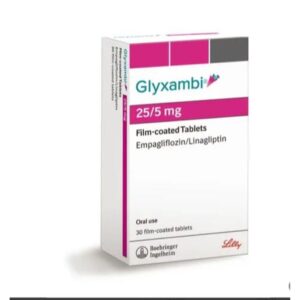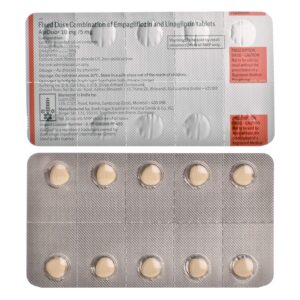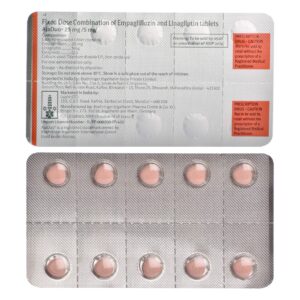LINAGLIPTIN + EMPAGLIFOZIN
Linagliptin: Linagliptin is an oral antidiabetic medication that belongs to the class of drugs called dipeptidyl peptidase-4 (DPP-4) inhibitors. It is primarily used for the management of type 2 diabetes mellitus.
The mechanism of action of linagliptin involves inhibiting the enzyme DPP-4, which breaks down incretin hormones such as glucagon-like peptide-1 (GLP-1) and glucose-dependent insulinotropic polypeptide (GIP). By inhibiting DPP-4, linagliptin increases the levels of GLP-1 and GIP, which in turn stimulate the release of insulin from pancreatic beta cells and inhibit the release of glucagon from pancreatic alpha cells. This helps to control blood sugar levels in individuals with type 2 diabetes.
The usual recommended dose of linagliptin is 5 mg once daily, regardless of meals. It can be taken alone or in combination with other antidiabetic medications, such as metformin.
Common side effects of linagliptin include upper respiratory tract infections, sore throat, headache, and joint pain. Although rare, some serious side effects have been reported, including pancreatitis, hypersensitivity reactions, severe joint pain, and bullous pemphigoid (a blistering skin disorder). It is important to monitor for signs of pancreatitis such as persistent and severe abdominal pain, as this can be a serious condition that requires immediate medical attention.
Linagliptin is generally well-tolerated and has a low risk of causing low blood sugar (hypoglycemia) when used alone. It is important to note that all medications have the potential to interact with other drugs, so it is vital to inform healthcare professionals of all the medications you are taking before starting linagliptin.
As with any medication, it is crucial to follow the prescribed dose and consult with a healthcare provider to ensure its safe and effective use.
Empaglifozin: Empagliflozin is a medication commonly used to treat type 2 diabetes mellitus. It belongs to a class of drugs called sodium-glucose co-transporter 2 (SGLT2) inhibitors.
The mechanism of action of empagliflozin involves inhibiting the SGLT2 protein, which is responsible for reabsorbing glucose in the kidneys. By blocking this protein, empagliflozin promotes the elimination of excess glucose through urine, reducing blood sugar levels in individuals with diabetes.
The usual starting dose of empagliflozin is 10 mg taken orally once a day in the morning. However, the dose may vary depending on individual response and tolerability. It can be taken with or without food.
Potential side effects of empagliflozin may include urinary tract infections, yeast infections in both men and women, increased urination, thirst, dizziness, low blood pressure, and increased cholesterol levels. Additionally, empagliflozin may increase the risk of ketoacidosis in individuals with type 1 diabetes or those with type 2 diabetes with a history of ketoacidosis. It is essential to discuss any side effects with a healthcare professional.
It is important to note that empagliflozin should not be used in patients with severe kidney impairment, as it may lead to further renal dysfunction. Pregnant and breastfeeding women are also advised against using empagliflozin due to limited safety data.
As always, it is crucial to consult with a healthcare professional before starting or altering any medication regimen.



